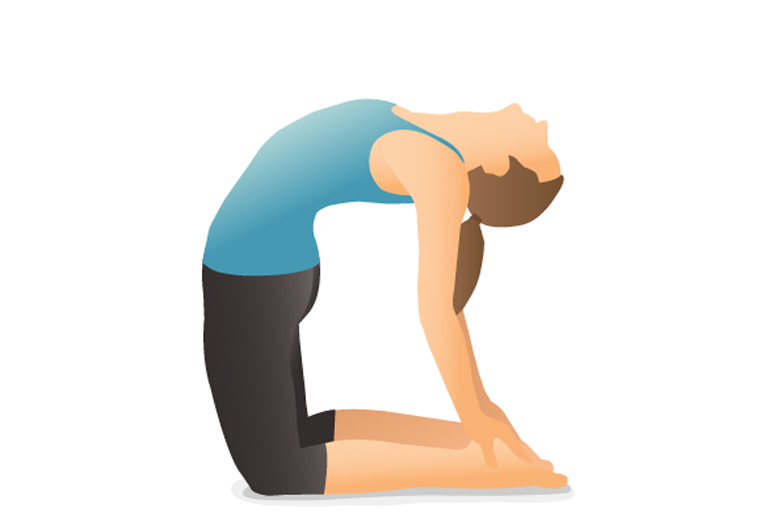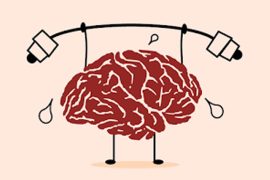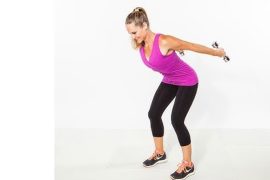Camel Pose, or Ustrasana, is a yoga posture that offers a deep stretch to the front of the body while simultaneously strengthening the back and legs. To practice, begin by kneeling on the mat with knees hip-width apart and hands resting on the lower back. Inhale deeply, lifting the chest towards the ceiling and arching the back, while gently reaching the hands towards the heels. Keep the hips stacked over the knees and engage the core for stability.
Camel Pose opens up the chest and shoulders, improves flexibility in the spine, and stimulates the digestive organs. It can also be beneficial for relieving fatigue and mild anxiety. As with any yoga practice, it’s important to listen to your body and avoid overexertion. Modifications, such as using props or reducing the depth of the backbend, can be made to suit individual needs and abilities.
How to perform Camel Pose (Ustrasana):
- Preparation: Start by kneeling on the yoga mat with your knees hip-width apart. Ensure your thighs are perpendicular to the floor and your shins are resting on the mat.
- Alignment: Place your hands on your hips, with your fingers pointing downward and your thumbs resting on your lower back.
- Engage Your Core: Engage your core muscles to stabilize your spine and pelvis. This will help protect your lower back during the pose.
- Inhale and Lift Your Chest: Inhale deeply as you lift your chest upward and slightly arch your back. Imagine lengthening through your spine as you do this.
- Lean Backward: As you continue to inhale, start to lean backward slowly. Keep your hands on your hips for support and maintain engagement in your core muscles to protect your lower back.
- Reach for Your Heels: If you feel comfortable, reach your hands back, one at a time, toward your heels. You can rest your hands on your heels or the back of your ankles, depending on your flexibility.
- Arch Your Back Further: Once your hands are resting on your heels or ankles, continue to arch your back and lift your chest toward the ceiling. Be mindful not to compress your lower back excessively; maintain a gentle arch.
- Keep Your Neck Neutral: Keep your neck in a neutral position or gently drop your head backward, being careful not to strain your neck.
- Hold the Pose: Hold Camel Pose for 20-30 seconds, breathing deeply and evenly. Focus on maintaining the stretch in your chest and front body while keeping your breath steady.
- Release the Pose: To come out of the pose, slowly bring your hands back to your hips for support. Engage your core muscles as you lift your torso back to an upright position.
- Rest in Child’s Pose: After releasing Camel Pose, rest in Child’s Pose (Balasana) for a few breaths to counterbalance the backbend and allow your body to relax.
Remember to listen to your body and only go as far into the pose as feels comfortable for you. It’s okay if you can’t reach your heels or if you need to modify the pose by keeping your hands on your lower back. With consistent practice, your flexibility and comfort in the pose may improve over time. If you have any existing injuries or medical conditions, consult with a yoga instructor or healthcare professional before attempting Camel Pose.
Benefits of Camel Pose (Ustrasana):
- Stretches the Front Body: Camel Pose provides a deep stretch to the entire front body, including the abdomen, chest, quadriceps, and hip flexors. This elongation helps to release tension accumulated from prolonged sitting or slouching, promoting flexibility and mobility in these areas.
- Improves Posture: By stretching the muscles along the front body and strengthening the back muscles, Camel Pose can help correct postural imbalances. Regular practice encourages a more upright posture, reducing strain on the spine and enhancing overall alignment.
- Enhances Spinal Flexibility: The backward bend in Camel Pose creates a gentle traction along the spine, facilitating increased flexibility and mobility. It encourages movement and extension in the thoracic and lumbar regions, which can alleviate stiffness and improve spinal health.
- Expands the Chest and Lungs: Opening the chest in Camel Pose allows for a deeper expansion of the rib cage, enhancing lung capacity and promoting more efficient breathing. This can be particularly beneficial for individuals with respiratory issues such as asthma or bronchitis.
- Stimulates the Thyroid Gland: The compression of the neck in Camel Pose stimulates the thyroid gland, which plays a crucial role in regulating metabolism and energy levels. This stimulation may help balance thyroid function and support overall metabolic health.
- Massages and Tones Abdominal Organs: The compression of the abdomen in Camel Pose massages the internal organs, including the stomach, intestines, and kidneys. This gentle massage can improve digestion, stimulate elimination, and enhance overall organ function.
- Alleviates Lower Back Pain: By strengthening the muscles along the spine and improving spinal flexibility, Camel Pose can help alleviate lower back pain caused by muscular imbalances or poor posture. It encourages a more balanced distribution of weight along the spine, reducing strain on the lumbar region.
- Promotes Emotional Release: Backbends like Camel Pose are known for their potential to release stored emotions and tension held within the body. As you open your heart and chest in this pose, you may experience a sense of emotional release, leading to feelings of lightness and emotional well-being.
- Increases Energy and Vitality: Camel Pose is invigorating and energizing, making it an excellent addition to your morning routine or midday stretch. The backward bend stimulates the nervous system, boosting circulation and revitalizing the body and mind.
- Cultivates Mindfulness and Focus: Maintaining balance and awareness while practicing Camel Pose encourages mindfulness and presence in the moment. Focusing on the breath and sensations in the body can help calm the mind, reduce stress, and improve concentration.
Remember to approach Camel Pose with mindfulness and respect for your body’s limitations. Listen to your body, breathe deeply, and only go as far into the pose as feels comfortable for you. With consistent practice, you can gradually experience the myriad benefits of this powerful yoga posture.
Who Should Avoid Camel Pose?
The Camel Pose, known as Ustrasana in yoga, may not be suitable for everyone, especially those with certain health conditions or injuries. Here are some cases where it’s generally not recommended to do the Camel Pose:
- Recent or Chronic Neck or Back Injury: If you have any neck or back injuries, it’s essential to avoid putting additional strain on these areas, as the Camel Pose can potentially exacerbate the problem.
- Knee Problems: People with knee issues, particularly if they have difficulty kneeling or bending their knees, may find the Camel Pose uncomfortable or challenging.
- High or Low Blood Pressure: This pose involves a deep backbend, which can affect blood pressure. Individuals with uncontrolled high or low blood pressure may need to avoid or modify this pose.
- Vertigo or Dizziness: The backward bend in Camel Pose can sometimes cause dizziness or vertigo, so those prone to these sensations should approach this pose cautiously or avoid it altogether.
- Pregnancy: Pregnant women, especially in the later stages of pregnancy, should avoid deep backbends like Camel Pose, as it could put excessive pressure on the abdomen and potentially harm the baby.
- Recent Abdominal Surgery: Those who have undergone recent abdominal surgery should avoid deep backbends like Camel Pose until they have fully healed and received clearance from their healthcare provider.
Safety Tips:
- Listen to your body and never push yourself into discomfort or pain.
- If you have any neck or back injuries, knee problems, or other health concerns, consult with a qualified yoga instructor or healthcare provider before attempting Camel Pose.
- Modify the pose as needed by keeping your hands on your lower back or using props such as blocks or a bolster for support.
Always consult with a qualified yoga instructor or healthcare professional before attempting any new yoga pose, especially if you have any pre-existing health concerns or conditions. They can provide guidance on whether the pose is safe for you and offer modifications if needed.
Disclaimer:
The information contained in this article is for educational and informational purposes only and is not intended as a health advice. We would ask you to consult a qualified professional or medical expert to gain additional knowledge before you choose to consume any product or perform any exercise.







